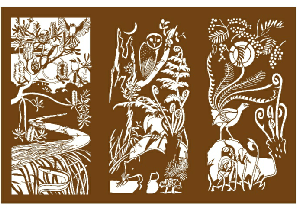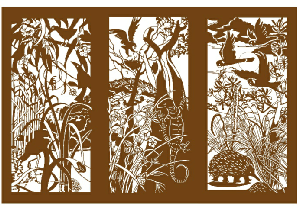JANINE GOOD

This artwork was designed by Drouin artist Janine Good as part of the Creative Recovery Project in Cardinia Shire undertaken by three artists between March 2020 and March 2022 for communities impacted by the March 2019 Bunyip State Forest Complex bushfires. The Project was partly funded by Victorian State Govt and coordinated by Cardinia Shire Council with assistance from the Creative Recovery Network. This design for Corten Steel Panels to be installed at Cannibal Creek Reserve was Janine’s contribution to the community, along with the designing and coordination of a Drystone construction in Tonimbuk and community workshops.
Janine Good Artwork Statement – ‘Mount Cannibal Changing Seasons’
“While a landscape can be immediately recognised by its landmarks and broader features it is also defined by the lifeforms that are sustained within it.
The recovery project landscape adjoining Bunyip State Forest with its granite underlay and the Mount Cannibal / Cannibal Creek to Bunyip River waterways supports a rich diversity of species making it a unique microcosm, that its human residents acknowledge and have great affection for.
The difficulty was deciding which of the thousands of species of plants and animals should be included. I wanted to create imagery that brought you into the world of these species, from their perspective, so I have taken the view sometimes under water, sometimes in the grasses or ground level of tiny orchids and sometimes in the treetops. I have included a nocturnal reference and a sunrise, the dry season and the wet.
The Eastern Kulin Nation Seasonal Calendar referenced from Museums Victoria was a good starting point, it provided a glimpse into the diverse environments that exist and the constant change with the seasons. We are indebted to the indigenous elders both past and present for the knowledge they have shared to help make this information available for future generations.
Where the Kulin Calendar was based mainly around food collection by our First Nations people, I have added some local stories into the imagery. I have shown the Helmeted Honeyeater because a population of the birds were released into Bunyip State Forest, an attempt at helping preserve the threatened species. I have included the Goanna and Wedge-
Each panel tells a story of the time of year shown by a circular sun symbol that grows larger as the seasons get hotter and shows some of the plants, fungi, animals and insects that live within and contribute to the uniqueness of this environment.”


List of Species for each panel:
NOTE: Indigenous plant and animal names (in capitals) are Kulin referenced from Museums Victoria educational program.
Eel Season (IUK) February to March Days & nights equal length
Animals: IUK Eel (Anguilla australis) and Dwarf Galaxias fish (Galaxiella pusilla)
Birds: Helmeted Honeyeater (Lichenostomus melanops cassidix)
Plants: Banksia marginata; Water Ribbon (Triglochin procerum)
Wombat Season (WARING) April to June Days short, nights long, coldest wettest
Animals: WARING Wombat (Vombatis ursinus); Grey Kangaroo (Macropus giganteus)
Birds: Sooty Owl (Tyto tenebricosa)
Plants: KOMBADIK Soft Tree Fern (Dicksonia antarctica); Eucalypt epicormic growth; Fungi; Coral Fern; Lomandra (Mat rush)
Orchid Season (GULING) July to August Days getting longer
Birds: BULEN-
Plants: KOMBADIK Soft Tree Fern (Dicksonia antarctica); MUYAN Silver Wattle (Acacia dealbata); Nodding Greenhood Orchid (Pterostylis nutans)
Tadpole Season (POORNEET) September to October Days nights equal length, bush burst into life
Animals: Brown Froglet (Crinia signifera) and Eastern Pobblebonk (Limonodynastes dumerlii), tadpoles
Birds: Pied Currawong (Strepera graculina); Dusky Moorhen (Gallinula tenebrosa)
Plants: Swamp Gum (Eucalyptus ovata) Common Reed (Phragmites australis); CUMBUNGI Bulrush (Typha domingensis)
Grass Flowering Season (BUATH GURRA) & Kangaroo Apple Season (GUNYANG) November to December -
Animals: Goanna /Lace monitor (Varanus varius); Common Brown Butterfly (Heteronympna merope)
Birds: BUNDJIL Wedge-
Plants: Tall Eucalypt; Kangaroo Apple (Solanum aviculare); Kangaroo Grass (Themeda triandra)
Dry Season (BIDERAP) January to February Hottest driest season
Animals: Echidna (Tachyglossus aculeatus); Ants
Birds: WARRAK Yellow-
Plants: Banksia marginata cones ripen, heat burst seeds open provide seeds for Black Cockatoos; Small Grass Tree (Xanthorrhoea minor) flowering; Poa Grasses (ensiformis and labillardierrei) flower